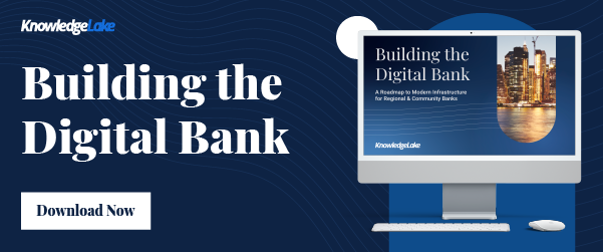Understanding the Drivers of Banking Automation: RPA and AI/ML
Two technologies are driving an evolutionary improvement in banking automation.
They are robotic process automation (RPA) and machine learning (ML), which is a form of artificial intelligence (AI).
These technologies are newer branches of the same automation tree where older technologies such as optical character recognition and forms processing live.
RPA uses virtual “robots” to automate repeatable business processes such as copying a loan account balance into a report, or moving files from one folder to another. These robots are programmed to complete repetitive tasks the same way every time. (One of the analysts we follow usefully observed that RPA should really be called RTA, or “repetitive task automation.”)
RPA bots are now deployed in at least 44% of organizations according to research from McKinsey.
Machine Learning takes a different approach. ML learns by example, identifying patterns and characteristics within datasets (for example documents, spreadsheets, and social media feeds) that a bank or credit union can use to better support decision making, mitigate risks, and improve customer experiences. In other words, ML identifies or extracts valuable data, then performs the appropriate actions based on that data.
Where RPA requires a human touch, ML does not. ML solutions can replace human intervention in manual processes altogether because these tools learn independently and develop their own logic and approaches to solving problems.
Think of ML as the brains and RPA as the muscle.
Stronger Together
When it comes to automation, it is not really a question of either/or. Banks and financial services firms are using RPA and ML together in a wide range of use cases. Primary ones include customer onboarding, residential and commercial lending, and compliance.
And it’s no longer just about these “traditional” focus areas where banking document automation can improve internal processes. Banks and credit unions are looking at loftier, more business-focused objectives such as reducing customer churn, detecting fraud, and increasing customer satisfaction and loyalty.
For instance, RPA and ML together can:
- Recognize behavioral patterns that indicate a customer might be shopping for a house or car
- Automatically tag all incoming customer documents with metadata to simplify compliance
- Reconcile payments
Proof that RPA and ML technologies are taking automation to the next level is evident in how financial institutions are spending in these areas. AI/ML budgets are growing by as much as 50% in over two thirds of organizations.
And for good reason. Amidst growing competition from FinTechs and customer demands, only financial institutions that embrace these technologies will thrive.
But it’s imperative that RPA and ML are integrated as part of a platform—specifically, an intelligent document processing platform.
Read our blog, “Automation Needs a Platform, Not Point Solutions,” to learn why integrating these technologies into a platform is key to achieving success with automation.
Joe Labbe
Joe Labbe is the VP of business development at KnowledgeLake. His primary responsibility is working with KnowledgeLake’s system integration and OEM partners to incorporate the KnowledgeLake intelligent automation platform into business solutions for their clients. Prior to joining KnowledgeLake, Joe was the founder and CEO of RPA software firm RatchetSoft.

